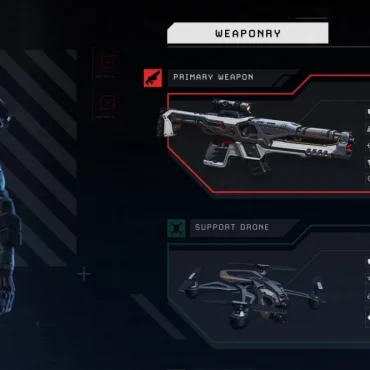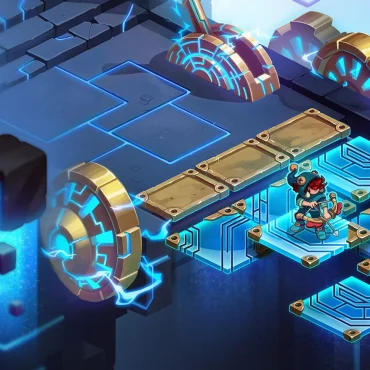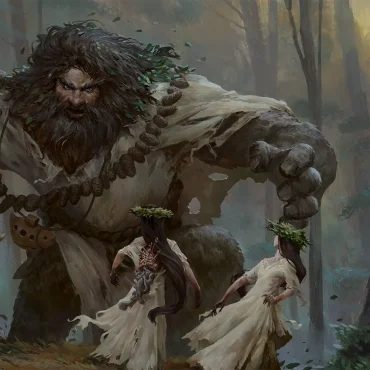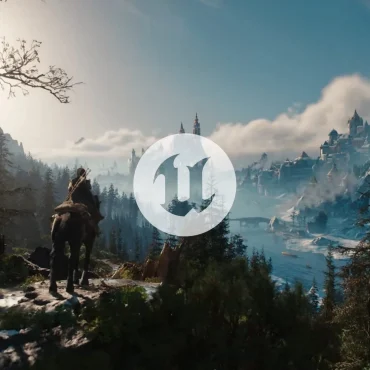Cyber Knights: Flashpoint is a tactical RPG in a neon-soaked cyberpunk setting that was recently launched for an alpha test. The game has a turn-based combat system and offers a dynamic story, sophisticated and challenging missions, and an endless variety of builds. Trese Brothers Games, the game’s developer and publisher, partnered up with N-iX Game & VR Studio to turn their vision into an appealing design with the help of our art production services.
We conducted an interview with Andrew Trese, one of the founders of Trese Brothers, where we talked about how they started creating games, their upcoming RPG in a cyberpunk setting, cooperation with N-iX Game & VR Studio, successful Kickstarter campaign, and even cat memes.
Highlights
- We never shy away from the complexity in games. In fact, we probably lean into complex systems really hard, which allows us to create games that have a lot of depth and replayability.
- I think N-iX was maybe the ninth studio that we were talking to. We were talking to a lot of studios at the same time. And N-iX was awesome from the get-go, cause you guys asked us a lot of questions, which made us feel comfortable that you were going to pay attention to what we wanted”
- We reached out to a couple of different studios that you guys had worked with to make sure that everyone else was happy with your work. We got all positive responses, so that was very confidence-building.
- We wanted it to be a partnership, not just that you guys are working for us.
- A Kickstarter is such a visual hook. People land on your page, see the gifts, watch the first 10-20 seconds of the video, and you have to make them interested. If those assets don’t catch their attention, they’re never going to read the text, they’re never going to scroll down, and they’re sure as hell never going to click the pledge button.
Says Andrew Trese.
Who is Who
- Andrew Trese, the mastermind behind Cyber Knights and other Trese Brothers’ games;
- Daniel Poludyonny, Head of Game & VR Studio;
- Arthur Tereshchuk, Writer at N-iX Game & VR Studio.
The Beginning of Trese Brothers and Game Development Vision

Arthur: How have you guys decided “we should probably make games,” and what is your story of success?
Andrew: We started in 2010 when my brother Cory and I were still working in enterprise software. We lived on different coasts of the country: he was in California, I was in Boston. Together we started creating a very hobby game project called Star Traders RPG. It was a Firefly or Dune-like space game where you fly around, pay your crew, and do missions across the galaxy. We posted it only on Google Play and were quite surprised when a lot of people got to play it. We were just making something for the two of us to share and didn’t intend to turn it into a game that we would be paid for. But there were so many people that started playing and emailing us with questions, suggestions, and complaints about solar distances and how big the universe was, and all sorts of things. We eventually put it on sale and interest just snowballed. So we realized we can make money making games and decided to keep doing that. And we’ve been making games ever since.
Arthur: What is your vision of video games, what makes Trese Brothers’ games stand out?
Andrew: We never shy away from the complexity in games. In fact, we probably lean into complex systems really hard, which allows us to create games that have a lot of depth and replayability. We give players a lot of options and let them come up with their own story and their own way. For example, in Star Traders Frontiers, our last game, we layered out nine professions (space smuggler, bounty hunter, intergalactic spy, explorer, etc.) and set this all have to play completely differently. You have to mix and match all the elements. Players have total freedom of how to play the game. So people will play a hundred-hour run of the game playing one way and then they can play a hundred hours another way. Based on the choices they have made, players often tell different emotional stories about the same game.
And I would say that another big thing that if people were to identify stuff about Trese Brothers games is that we hang out and talk to the community. We source a ton of good ideas from them, for sure. We always read and take the suggestions very seriously cause we have a history of finding that it makes our games better. We have players suggest straight-up items with stats, and if there is the right item we will put it in the game. It’s really helpful.
Upcoming Game Cyber Knights: Flashpoint

Arthur: Considering your upcoming game, Cyber Knights: Flashpoint, it is the second game of the Cyber Knights franchise that takes place 14 years later from the Cyber Knights RPG. Why have you decided to make a sequel?
Andrew: As a company, we have made five games, and two of them were in the same world. We realized that our community loves those worlds, and we wanted to not really make sequels, but build the game worlds and tell stories by moving the time along. So from there, we started going back, basically making not sequels but games that progress the storyline. Star Traders Frontiers is set 200 years after the original Star Traders. It has a lot of similarities in its concepts. It’s the same world, and players who love the first game can see the play out of the choices they may have made in this galaxy. Experience the changes and keep playing.
So once we hit the fifth game, we decided not to make any more totally new, but rather go back to the beginning and refresh the titles. We did Star Traders, Templar Battle Force, which is a refresh of Templar Assault, and now we’re back to Cyber Knights. We had made this decision in the time of Cyberpunk 2077’s first trailer and then actually got serious about making the game. So we had already sailed on this pretty much before they made everything popular, but it’s good timing for us.
Arthur: Probably the most catchy difference between the first and the second parts of Cyber Knights is the 3rd dimension. How do the development process and art production differ when you develop 2D games and 3D games?
Andrew: Yeah, obviously super different. This is our first 3D title, so we waited many years before we tried to upgrade. We always wanted to make sure that we had enough success as a studio. That is if we upgraded to 3D, we would be able to do it with a partner who could deliver awesome 3D.
How was the process different? I mean, it’s a good question. With 2D you have a very limited ability to express certain things that happen in the game. With 2D art, if you want to have some sort of cut scene or cool thing to happen, you may need to develop art specifically for that. Whereas in 2D plus 3D you create a whole bunch of assets that can be reused in lots of different ways to create many different scenarios, setups, angles, and looks on things. You can change the lighting and it feels very different.
What I’m excited about, especially from a story and a world-building perspective, is that with all this 3D art that N-iX artists have created, we’re much more flexible. It can help us make a house that the characters live in and set up scenes where the characters walk around and talk to each other. And with some extra assets pulled in, we can show the city in different ways. And that stuff is very difficult. 2D art is often really specific – once made, it has a single purpose. You can’t rotate it, flip it upside down, blow it up, or anything like that. If you want to blow something up in 2D, you probably need to make sprites that show it blowing up specifically.
That’s why I am excited about 3D. It costs a lot more to get it, but once you have it, you have a lot more potential with what you can do.
Daniel: Besides, I think that when you go completely 2D, you need to render all those shadows and stuff, and there’s much less customizability to what you can do. When you make a 3D-asset-based game, you can then reuse those assets quite a lot, shuffle them and create new content based on the existing one.
Andrew: Exactly. With 2D you plan exactly how it’s going to work and then, as Dan said, it has limited use. 3D seems pretty like we can do tons and tons of stuff with this. We have a guy, our youngest brother actually, who’s doing texturing for us now. So he’s taking stuff that N-iX has made and then going in and retexturing things. Taking walls, floors, crates, swords, and all sorts of things and just put new material on it and you get a new looking thing. He’s super excited to do face tattoos for characters because we now can do face tattoos for characters. We have a character-building system in Star Traders Frontiers, but it’s very delicate and restricted. You could never add face tattoos in 2D. It’d be impossible, but the guys at N-iX just modified our shaders and put face tattoos on all the characters. So I think you can get a lot more mileage out of 3D.
Cooperation with N-iX Game & VR Studio

Daniel: You wanted to partner with a team capable of delivering the entire pipeline: starting with concept art and then modeling, texturing, rigging animation, and visual effects. I believe you decided to go with some outsourcing companies and external teams. How was that process looking back then and how did you end up choosing N-iX?
Andrew: We knew some of what our budget restrictions would be and we went looking for studios. We talked to 14 different studios, and N-iX was one of them. We had an idea of what we wanted, but it was our first 3D game, so we also knew we had a lot to learn from every studio.
We sent a request for a quote to every one of the studios we had. With most of them, we ended up on the phone. Our goal was to show the team what we thought we wanted and then get some ideas from them. See what their concept art, 3D team, and animation team could do. Be it a good reference sheet, a chat on the phone, sample assets, maybe even custom assets made to impress us and get us on the deal.
And we quickly learned a lot. I think N-iX was maybe the ninth studio that we were talking to. We were talking to a lot of studios at the same time. And N-iX was awesome from the get-go, cause you guys asked us a lot of questions, which made us feel comfortable that you were going to pay attention to what we wanted. So that was a very good starting point.
What we found pretty quickly was that there were a number of studios that just wanted your list and then were like “Oh, we’ll do it for you. Don’t worry, we’ll take care of this,” which felt very scary to us because it’s such a big project and it’s going to be the backbone of the game.
We were going to make a lot of cool game systems and stories and things. But game art is a sort of the poster, the marketing, it’s everything. Basically in some regard, it’s critical to the game to be successful. So we wanted someone who felt like a partner, who we could really trust, who was going to talk to us about stuff. N-iX was responsive, really asking a lot of questions. Then we reached out to a couple of different studios that you guys had worked with to make sure that everyone else was happy with your work. We got all positive responses, so that was very confidence-building.
Our goal is always to find a partner that we can stick with. 14 studios. It took us about six months to find you guys. It’s expensive to find a partner and we really wanted someone who could do everything. We were very happy that N-iX could do the whole stack of art, that you had Unity developers (and maybe in the future we’ll work with you on coding), that you had people that did shaders and animation. You really are a full-service studio.
In the past, we’ve worked with 2D teams and then hired an outside animator. It’s very difficult to get people to align really cleanly. After having selected you guys, one of the things that makes me the happiest is that your teams internally work really closely together. There was never any major point of confusion. Everybody is working together to make sure that it’s all gonna work.
Daniel: Yep, that’s pretty much an answer. From my end, I would like to add that for the team and for everybody who’s been working on Cyber Knights: Flashpoint, before the Kickstarter campaign and after it, it was a huge pleasure. The inclusion that you make for the team into your processes is great, and we’re feeling so blessed to work with you guys and contribute to this specific project. And the parties were super great.
Andrew: I think that the two other things that we were looking for in a partner, Dan, is that we really wanted somebody who could not only make sure that we ended up with amazing stuff but would also buy in creatively to the project and be excited about it.
I’m an artist, I know that when you’re excited about something you work, you do produce better quality stuff. So the teams that said “Oh yeah, we’ll do that. Just give us your list. We’ll take care of it,” scared us a little bit, because we didn’t know who’s gonna do it. We wanted to talk to the same people every day and know that we have great artists working on it.
One of the other things that have been really fun is when we gave the concept to our team, and we said “Hey, why don’t you guys do some outfits? Why don’t you think up within this world, what fits you,” to engage you guys creatively as well. So I think that’s been really fun and that’s one of the reasons we threw the parties. We wanted it to be a partnership, not just that you guys are working for us.
And I think it’s shown in the team that has gone above and beyond so many times to find solutions to really hard or complicated problems. That makes us super happy. And that’s what we were looking for. We got the feeling that when we sat down with you guys in those early meetings, the number one thing that stuck out to us was a willingness to communicate good things and problems. You guys told us about stuff that was going to be easy, like “Oh yeah, okay, we can do that. Here’s the hour count,” and that’s pretty straightforward. But then you also warned us about stuff like “do you have any idea how that’s going to work? That could be difficult. That might cost more money.” And we got a real feeling early on that all the teams were thinking about it, and that we were getting a real look from the team about how we can deliver.
So I would say for us, the number one thing that did stick out about N-iX was that you communicated well about the project, and that indicated that you’re going to be engaged the whole way through. It was probably our biggest decider. That’s helpful.
Kickstarter Campaign

Arthur: How have you approached the Kickstarter preparation process and how N-iX studio was involved in the campaign? And since it was your third Kickstarter project, maybe you can share some interesting or helpful insights about launching a successful campaign?
Andrew: It’s a whole subject we could do an hour on. I think one of the big things about Kickstarters is that it requires a huge amount of prep. To be successful, you’d need a bunch of time. Without a doubt, a lesson learned from our previous two Kickstarters was that we didn’t prepare enough and we didn’t have enough of the game assets to be able to show what really the game was going to look like.
We had to start a campaign in February because Cyberpunk 2077 was going to launch in April, supposedly. So we really felt like we had to launch. We wanted to make a Kickstarter before they launched the game. That didn’t happen, but we still were stuck to the date. That put us on a little tighter schedule with you guys than we wanted.
N-iX was super helpful and produced a bunch of videos and did high-priority assets that we needed. And you guys made a bunch of 3D renders for us and things. So basically I would say that everything visually we showed in the Kickstarter that was awesome looking was pretty much thanks to you guys.
A Kickstarter is such a visual hook. People land on your page, see the gifts, watch the first 10-20 seconds of the video, and you have to make them interested. If those assets don’t catch their attention, they’re never going to read the text, they’re never going to scroll down, and they’re sure as hell never going to click the pledge button. So we were really happy that you guys helped us produce, that was really valuable.
And then again, literally, everything we showed, except for wireframe diagrams, flow charts, and stuff, which is not art, it’s Google docs, was pretty much done by you guys. On Kickstarter, especially with games, people want to see what it’s going to look like, and that was hugely helpful.
Also, there is one thing about Kickstarter. We had a great plan, we had all these stretch goals planned and a funding goal, we had updates prepared in advance. We were ready to go, that plan is not going to change. And then as soon as it gets going, the plan starts to change. You’ve worked really hard, you’ve shown your community what you’re going to do, you’ve previewed it to a bunch of people, and you thought you knew what the crowd wants. But then, once it’s live, you start to get all sorts of different feedback.
For example, we had not planned to add cats as a feature in the game, we’ve always had dogs, but the number of people asking about cats was insane. We had no idea. To pet the dog was a big deal, we knew that everybody was gonna want to pet the dog, but there are also cat people. They are easily 50% of the Internet, and I guess we should’ve known that. So, we had absolutely no plan to do anything with cats, and then halfway through the Kickstarter, we were like – “we gotta add cats!” We have to have them. People are just losing their minds. So we went back to N-iX and the team helped us put together concept art for cats in a hurry so that we could do cats later that week. We announced that if we get to a new funding goal, we would do cats.
It was exciting to put some beautiful cat art on Twitter. Our social guy made a ton of memes out of it, he was quite busy with it. So, to be in the middle of Kickstarter and be able to say “We really need something from you guys right now, can you help us do this?” was so valuable.
Daniel: I remember that time really well – the voting for the cats. I think I also voted for the snow leopard. What were the other two options?
Andrew: A Siberian tiger and lynx I guess. The snow leopard won out pretty, pretty big.
Daniel: For us, it was so intense watching the Kickstarter campaign every day. Every morning started with refreshing the page and looking at what’s going on in there. And we even had a little bet during that party. There were around 12 people and everybody would guess a number that you guys are gonna make out of this Kickstarter campaign. It ended somewhere like about 300k at the top, and the least optimistic forecast was around 50k. So, it turned out to be above the average of what people were expecting of it.
Andrew: Yeah. I think it shows exactly what you can get with good assets behind. Because there are just so many people that visit the page and you just need some visuals that grab them. And that was really what N-iX made possible for us. We have learned so much from you guys. I think the team has learned some pretty awesome things in trying to find answers to all the hard questions that we’ve done, all those creative solutions.
And now, everybody here is super excited about the chance to sit back down on a new project with a new budget and come back for game two. We got to finish Cyber Knights, it’ll be a while, but when it happens, we’re coming back to you guys. It’s been awesome. We’re very happy.
Support for Ukraine

N-iX Game & VR Studio team also wants to thank Trese Brothers Games for being among the first of our partners who immediately expressed support for Ukraine and N-iX when Russia declared war on 24th of February, 2022:
The entire Trese Brothers team is heartsick and worried to see the invasion and wanton destruction of their country – missile strikes hitting hospitals, apartment buildings, even kindergarten schools. We are scared for our friends, their families and their children.
…
My brother Cory and I have worked closely with amazing partners in Ukraine to dream, design and create the art of Cyber Knights: Flashpoint over the past 3 years. Over that time, our partnership has grown to friendship
Our studio and country are lucky to have such amazing people on our side. For now, we are looking forward to playing Cyber Knights: Flashpoint and working on new exciting projects after our victory!




